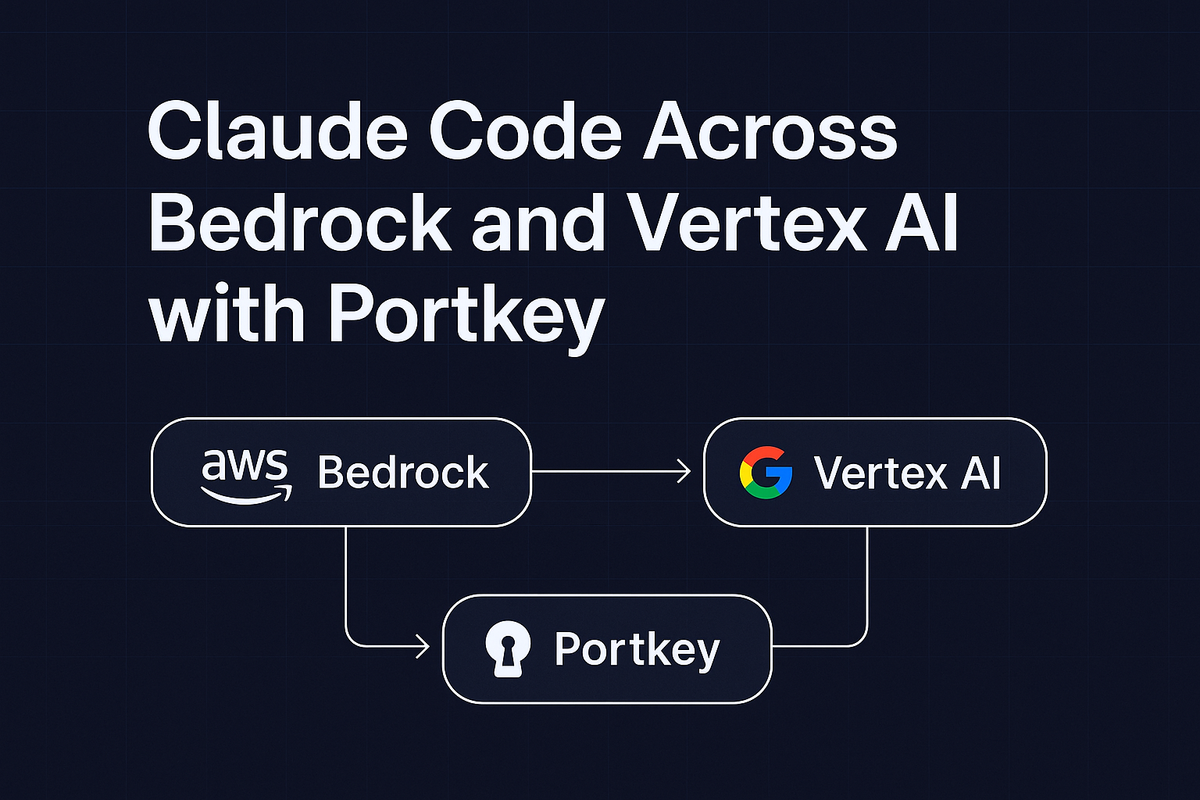How to use Claude Code with Bedrock, Vertex AI and Anthropic
Run Claude Code across Amazon Bedrock and Vertex AI for higher reliability, rate-limit resilience, and cost control.

Claude Code is quickly becoming a go-to choice for AI-assisted coding—offering developers powerful capabilities for code generation, refactoring, and understanding.
Today, if you want to use Claude Code, you typically have to choose a single provider:
- Amazon Bedrock
- Google Vertex AI
- Anthropic API directly
That single choice works fine in simple setups, but for teams running AI in production, it can quickly become a bottleneck. If your chosen provider has downtime, hits rate limits, or is unavailable in certain regions, your workflows slow down or stop entirely.
With Portkey, that changes.
Use the latest models and learn how teams are running LibreChat and Claude Code securely with RBAC, budgets, rate limits, and connecting to 1,600+ LLMs all without changing their setup.
To join, register here →
What’s the problem with the current Claude Code set up?
Most current Claude Code setups are tied to one provider. You pick Bedrock, Vertex AI, or Anthropic and all your requests go through that single path.
This creates a few challenges for production teams:
- Downtime risk – If your provider has an outage or degradation, you’re stuck waiting.
- Rate-limit ceilings – Providers cap request throughput, so scaling up often means hitting limits.
- Regional gaps – Some providers are only available in certain geographies, leading to latency or compliance issues.
- No cost flexibility – You can’t easily compare or route to the more cost-effective option.
When you’re operating at scale, these constraints aren’t just inconveniences—they directly impact uptime, user experience, and spend.
How Portkey enables Claude Code across Bedrock + Vertex AI
Portkey lets you connect multiple Claude Code providers like Bedrock and Vertex AI, additional to Claude Code into a single, unified endpoint. Instead of committing to one provider, you can run them in parallel or route requests intelligently based on your rules.
A typical setup looks like this:
- Add both providers – Configure your Bedrock and Vertex AI credentials in Portkey.
- Define routing logic – Send requests to Bedrock by default, fall back to Vertex AI if limits are hit or errors occur.
- Enable failover – If one provider is unavailable, Portkey automatically retries on the other.
- Mix and match – Add Anthropic’s API or other supported models into the same workflow if needed.
This means your application keeps running smoothly even if one provider is slow, down, or rejecting requests. And because it’s all handled at the gateway level, you don’t have to rewrite your application code to switch providers.
Benefits of multi-provider Claude Code with Portkey
Running Claude Code across Bedrock and Vertex AI through Portkey gives you:
- Higher reliability – No single point of failure; smart routing strategies keeps you afloat
- Rate-limit resilience – Distribute traffic across providers to bypass individual caps.
- Regional coverage – Route requests to the closest provider for lower latency and compliance needs.
- Performance optimization – Dynamically pick the faster provider based on real-time metrics.
- Cost efficiency – Track spend across providers and route to the cheaper option.
Instead of being boxed in by one provider’s limits, you get the freedom to operate at scale without trade-offs.
Multi-provider routing is just the start. Portkey adds a full set of production-ready capabilities for Claude Code:
- Cost & usage tracking – Monitor every request, broken down by provider, route, team, and user.
- Caching – Avoid reprocessing identical requests, saving time and spend.
- Guardrails – Enforce content filters, policies, and safety rules on every response.
- Observability – Debug requests and responses across all providers from a single dashboard.
- Access controls – Assign model usage by team or workspace to stay compliant and organized.
With these built-in features, you can move from experimentation to stable, governed production use without bolting on extra tooling.
Powering up your Claude
Claude Code is powerful on its own but when you can run it across Bedrock and Vertex AI at the same time, it becomes far more resilient, scalable, and cost-effective.
With Portkey, you’re not tied to a single provider’s limits. You can route intelligently, handle failovers automatically, and gain visibility into every request—while also adding caching, guardrails, and governance from day one.
For teams running AI in production, this means fewer interruptions, faster responses, and more control over spend. The result: a smoother developer experience and a better end-user experience.
To get started, book a detailed walkthrough or try it yourself!
